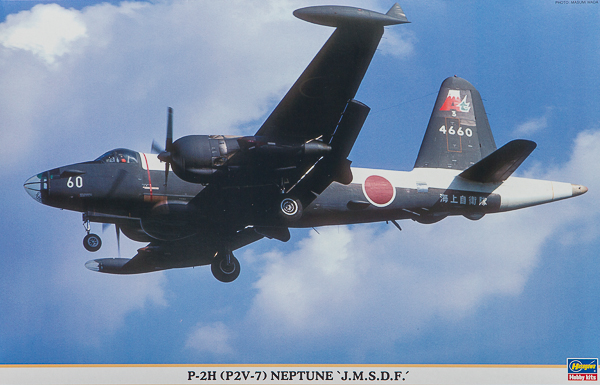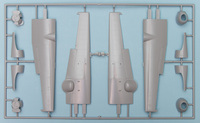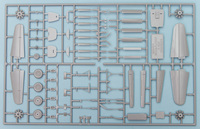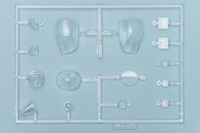
Hasegawa 1/72 P-2H (P2V-7) Neptune "J.M.S.D.F."
By Chris Banyai-Riepl
Overview
The Lockheed P2V Neptune was derived as a replacement for the PV-1 Ventura and PV-2 Harpoon as a land-based naval patrol bomber. Design began as a private venture in the early 1940s, and the first P2V took to the air in 1945. The type quickly entered production, and the US Navy began operations in 1947. The Neptune soon proved its value, and soldiered on in the service of many nations, including Argentina, Australia, Brazil, Canada, Chile, France, Japan, Netherlands, Portugal, Taiwan, and the United Kingdom, as well as the US Navy, Marine Corps, Army, and even the CIA. Once retired from service, the Neptune also saw service as firebombers.
The Kit
 Hasegawa's 1/72 P2V kit dates back to the 1970s and it remains the only choice for this aircraft in any standard scale, with Revell and Frog having done the Neptune in odd box scales. The kit, being from the 1970s, is accurate in shape but is lacking in the details, and also features raised panel lines. This particular release comes with Japanese Maritime Self Defense Force markings, with two choices included.
Hasegawa's 1/72 P2V kit dates back to the 1970s and it remains the only choice for this aircraft in any standard scale, with Revell and Frog having done the Neptune in odd box scales. The kit, being from the 1970s, is accurate in shape but is lacking in the details, and also features raised panel lines. This particular release comes with Japanese Maritime Self Defense Force markings, with two choices included.
 Diving into the construction, the kit begins with the cockpit. The Neptune has a fairly closed-in canopy, but you can still see a fair amount of detail through the glass. The kit, typical of a 1970s release, only provides the most rudimentary details, so you will probably want to track down one of the resin or photoetch detail sets for this area. For a straight out of the box build, though, you get a couple of seats with a pair of figures, a front bulkhead, and a rear bulkhead. A separate instrument panel piece is also included, and there are decals for both the instrument panel and the center console. For the nose section, there is another seat and figure.
Diving into the construction, the kit begins with the cockpit. The Neptune has a fairly closed-in canopy, but you can still see a fair amount of detail through the glass. The kit, typical of a 1970s release, only provides the most rudimentary details, so you will probably want to track down one of the resin or photoetch detail sets for this area. For a straight out of the box build, though, you get a couple of seats with a pair of figures, a front bulkhead, and a rear bulkhead. A separate instrument panel piece is also included, and there are decals for both the instrument panel and the center console. For the nose section, there is another seat and figure.
 With those interior bits done, you get to insert a bunch of small windows along both fuselage sides, then you can button up the fuselage. The instructions indicate to insert some weight in the nose, and that's a definite need on this kit. It will be permanently on its tail without that extra weight. Luckily, there's lots of places to hide it away here (the belly radome is perfect).
With those interior bits done, you get to insert a bunch of small windows along both fuselage sides, then you can button up the fuselage. The instructions indicate to insert some weight in the nose, and that's a definite need on this kit. It will be permanently on its tail without that extra weight. Luckily, there's lots of places to hide it away here (the belly radome is perfect).
 The next step is the engines, and these come with both rows of cylinders as separate pieces. The completed engine is then trapped between a one-piece forward cowl and a rear nacelle piece. While the engines are fairly basic, the cowl is very tight-fitting around them, so not much will be visible. Some washes and drybrushing will be all that's needed there. The propellers have separate blades and a two-piece hub, and the blades do not have a keyed peg to ensure the proper angle, so it would probably be best to create a jig for these.
The next step is the engines, and these come with both rows of cylinders as separate pieces. The completed engine is then trapped between a one-piece forward cowl and a rear nacelle piece. While the engines are fairly basic, the cowl is very tight-fitting around them, so not much will be visible. Some washes and drybrushing will be all that's needed there. The propellers have separate blades and a two-piece hub, and the blades do not have a keyed peg to ensure the proper angle, so it would probably be best to create a jig for these.
 The rest of the assembly is very straightforward. The wings are split into upper and lower halves and feature some incredibly durable and rigid alignment tabs. The ailerons are separate, as is the rudder. The horizontal stabilizers are split into upper and lower halves as well. The landing gear is well detailed for a kit of this age, with two separate retraction arms and separate oleo scissors on the main gear. The landing gear is enveloped by the two-piece engine nacelle, making it very easy to add extra wheel well detailing should you so wish. The nose gear is a bit simpler, but still features a separate retraction arm.
The rest of the assembly is very straightforward. The wings are split into upper and lower halves and feature some incredibly durable and rigid alignment tabs. The ailerons are separate, as is the rudder. The horizontal stabilizers are split into upper and lower halves as well. The landing gear is well detailed for a kit of this age, with two separate retraction arms and separate oleo scissors on the main gear. The landing gear is enveloped by the two-piece engine nacelle, making it very easy to add extra wheel well detailing should you so wish. The nose gear is a bit simpler, but still features a separate retraction arm.
With the main airframe together, all that's left are the small details. The exhaust pipe sections are separate pieces, as are the cowl flaps. The jet pods are a simple right/left assembly, as are the tip tanks, with the searchlight one getting a separate light and clear dome. There are a few extra antennae for the fuselage, plus the canopy and clear nose piece, and attention can turn towards painting.
 Both options on the decal sheet share the same basic color scheme consisting of a white fuselage top and tail boom with the rest of the plane finished in Engine Gray. The only differences in markings are the nose numbers and tail markings. The first option is 4660 from the 3rd Squadron based at Atsugi, while the second option is 4655 from the 4th Squadron based at Naha. The decal sheet provides lots of stenciling as well as the large wing walkways.
Both options on the decal sheet share the same basic color scheme consisting of a white fuselage top and tail boom with the rest of the plane finished in Engine Gray. The only differences in markings are the nose numbers and tail markings. The first option is 4660 from the 3rd Squadron based at Atsugi, while the second option is 4655 from the 4th Squadron based at Naha. The decal sheet provides lots of stenciling as well as the large wing walkways.
Conclusion
It's great to see Hasegawa re-release this classic kit, as it remains the only choice for those wanting a model of the P-2 Neptune in their collection. My thanks to Hasegawa USA for the review sample.
